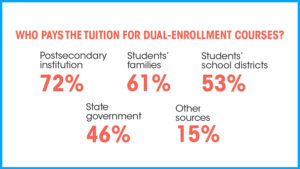There are more high school students taking courses for credit from Tompkins Cortland Community College (TCCC) in upstate New York than there are students at the college itself.
Some 3,200 full- and part-time students are enrolled in more than 50 degree and certificate programs at TCCC. But more than 5,100 high school students from 60 K-12 school systems — some as far as three hours away — take TCCC courses at their local high schools through a dual-enrollment program called CollegeNow, one of the oldest such programs in the state.
The program helps provide a “seamless transition” from high school to college, says Victoria Zeppelin, director of CollegeNow.
As students simultaneously earn high school and college credit, they’re getting a jump on their college experience, which can significantly reduce the amount of time it takes them to earn a degree. In fact, “we had 31 students graduate from high school last year with an associate degree from the college,” Zeppelin said.
Growth area
CollegeNow is a striking example of how popular dual-enrollment programs have become. During the 2010-11 academic year, more than 1.2 million U.S. high school students took courses for college credit within a dual-enrollment program, according to the National Center for Education Statistics — and experts say that number has continued to climb.
“As states look at how to move the needle on college enrollment and completion, dual enrollment is a strategy that has been proven to work,” says Adam Lowe, executive director of the National Alliance of Concurrent Enrollment Partnerships. “If students come to college with credits under their belt, that often gives them the momentum they need to succeed.”
Successful dual enrollment programs begin with strong, collaborative partnerships between community colleges and their local K-12 school systems, says Daniel Domenech, executive director of AASA, the School Superintendents Association. They also require clearly articulated agreements that spell out what each entity’s responsibilities.
This excerpt comes from the current issue of the Community College Journal, which has been published by the American Association of Community Colleges since 1930.
For example: Who’s going to teach the courses? Will the instruction take place at the high school or at the community college? What courses will be offered for dual enrollment, and what credit will be given? How will the costs be shared? Will the students have to pay tuition—and if so, at what rate?
When these arrangements are worked out satisfactorily, “then everybody benefits,” Domenech says. “But the devil is in the details.”
Who teaches the courses
Dual-enrollment programs can take many forms. TCCC mainly offers a “concurrent enrollment” model, in which high school students can take college-level courses in their own school, taught by high school faculty. These instructors become adjunct faculty for the college, and they must go through a rigorous process to ensure their course meets the college’s high standards.

Source: National Center for Education Statistics
“The instructors have to submit their credentials, and we have faculty assigned in every discipline to review those credentials,” Zeppelin says. “Once an instructor is approved as an adjunct, he or she must attend training. We share the expectations for the course, and the instructors send us their course syllabus for approval. We have to see what it is they plan to teach and whether it aligns with the learning outcomes we expect.”
Offering dual-enrollment courses in the high schools provides greater access for students, because they don’t have to travel to campus.
“Transportation can be a significant barrier, especially in rural settings,” Lowe says. It also alleviates concerns about whether high school students are socially or emotionally ready to learn in a campus environment.
On the other hand, being on a college campus exposes high school students to a more authentic college experience. What’s more, many high schools lack instructors who are qualified to teach a college-level course.
Sampling college
At Snead State Community College (SSCC) in Boaz, Alabama, about 200 to 250 students from 21 area high schools receive dual-enrollment credit each year. At nine of those schools, students take the courses within their own school, while students attending the others travel to the Boaz campus to take courses taught by college faculty.
Dual-enrollment courses are “an opportunity to introduce college to a population who wouldn’t normally think about it,” President Robert Exley says. “Students get access to our Academic Success Center, which provides tutoring and early alerts, and they are encouraged to take part in campus activities. Our goal is to have them see themselves as a normal college student.”
Read the full article in Community College Journal online.

